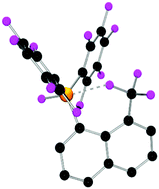A model for C–F activation by electrophilic phosphonium cations†
Abstract
The synthesis of the electrophilic phosphonium cation (EPC) salt [C10H6(CF3)PF(C6F5)2][B(C6F5)4] 4 was achieved via oxidation of phosphine [C10H6(CF3)P(C6F5)2] 2 with XeF2 to form phosphorane [C10H6(CF3)PF2(C6F5)2] 3 and subsequent fluoride ion abstraction. Structural and spectroscopic characterization of 4 provides evidence of an interaction between the CF3 functionality and the phosphonium centre. AIM and NBO analyses also support donation from a lone pair on a fluorine atom of the CF3 group to the P–F σ* orbital of the fluorophosphonium unit, consistent with previously proposed mechanisms for main group C–F bond activations.



 Please wait while we load your content...
Please wait while we load your content...